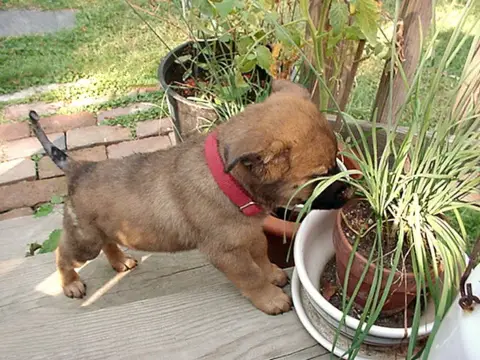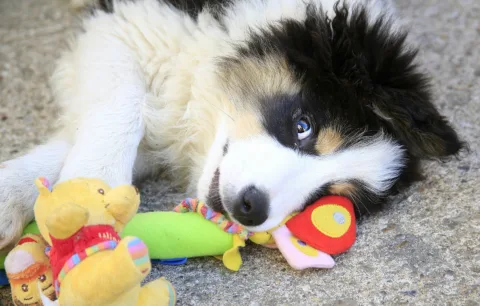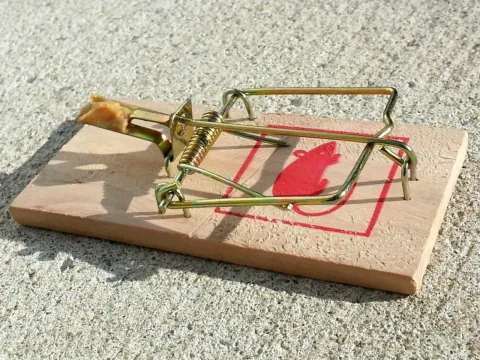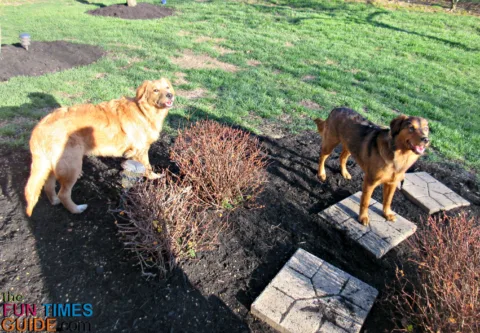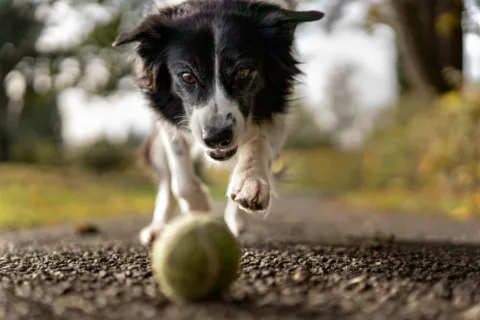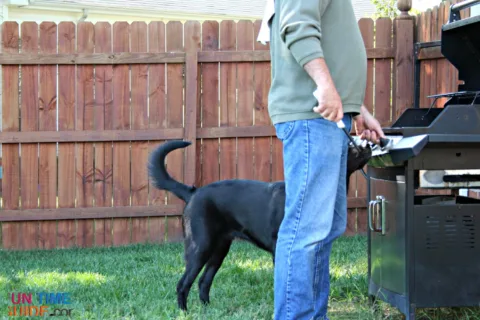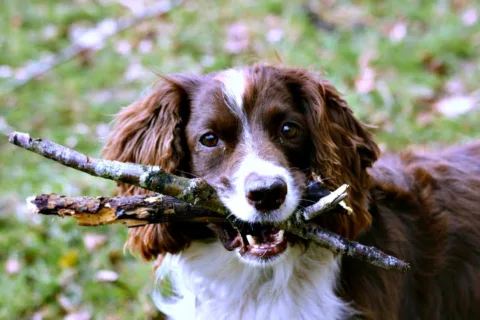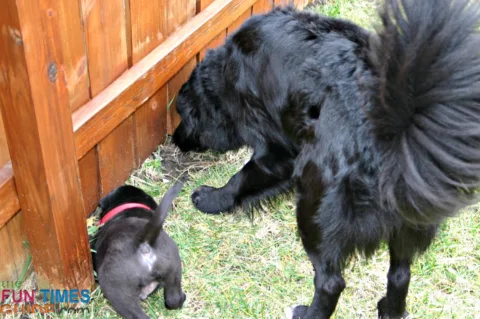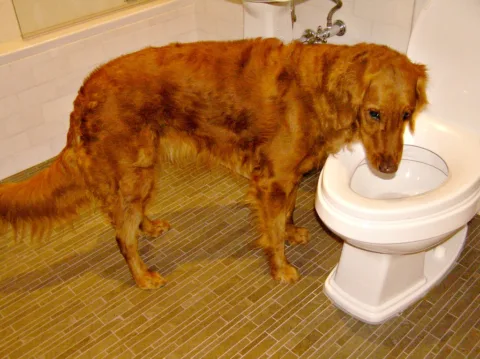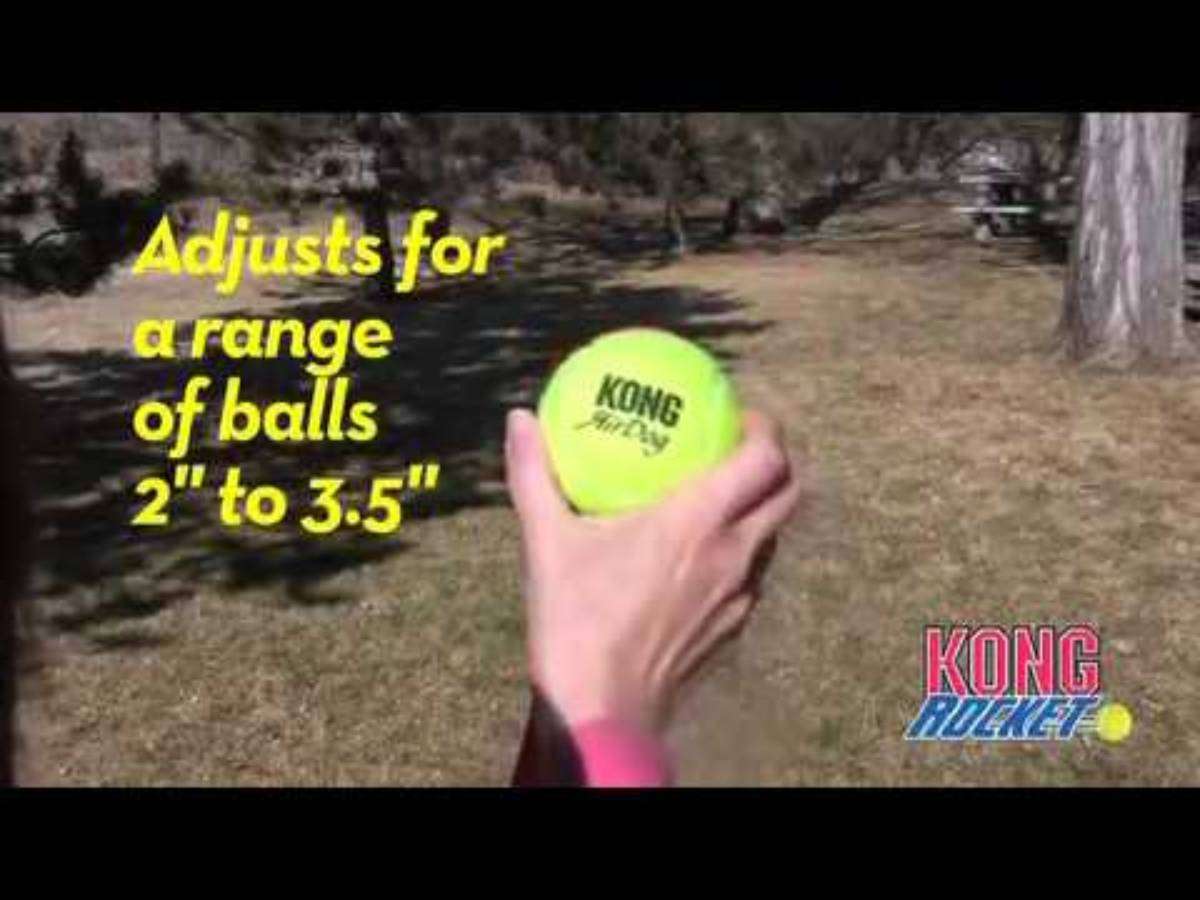As a lifelong dog owner and full-time employee at a veterinarian’s office, following are some of the things that I’ve seen can be deadly to a dog — and a reason that puppy proofing before you bring your dog home is so important.
Most of us are keenly aware that there are a number of plants that are poisonous to dogs.
And many of us have it ingrained in our brains that there are lots of human foods that dogs cannot eat.
But there are a number of other very common household items that many (especially first time dog owners) would never think of as being harmful to dogs.
So when you’re puppy proofing, be sure to modify the following items first — both inside and outside your home — to keep your dog safe.
How To Puppy Proof Your House
Here are 10 things you should look at right away when you’re puppy proofing your house:
#1 – Rocks
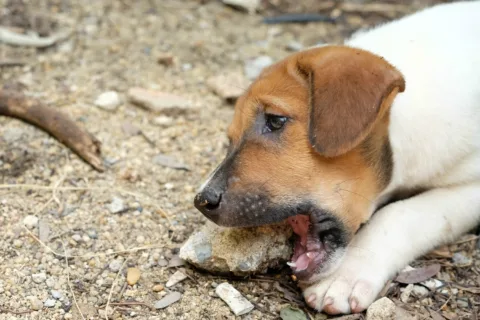
WHY THIS IS DANGEROUS: They look innocent enough, but rocks can be deadly to dogs if they’re swallowed. If your dog likes to chew rocks, you should never leave him unsupervised in the yard alone. Sometimes the rocks can be surgically removed from a dog’s intestines. Other times, consistent rock chewing can lead to a lifetime of expensive medications and special diets. And still other times, dogs swallowing rocks don’t survive. WHAT YOU CAN DO: Try to divert your dog’s attention from chewing on rocks to chewing on a dog toy instead.
#2 – Mousetraps
WHY THIS IS DANGEROUS: Rodent poisons and insecticides are one of the most common sources of pet poisoning. For this reason, you’ll have to strategically place any mouse traps or other bait you use to catch cockroaches, ants, or other insects in and around your house. WHAT YOU CAN DO: 1) Buy dog safe mouse traps, or 2) Place mouse traps in small, tight spaces where your dog cannot reach. (Make sure your dog cannot “paw” at the trap if he reaches really far!) TIP: One way to help deter dogs from playing with mousetraps is to place the traps inside a small brown paper sack before you place them around the house. This also makes the trap more inviting for the mouse (because they love small, dark spaces) and it makes clean-up a breeze!
#3 – Mulch
WHY THIS IS DANGEROUS: Mulch containing theobromine is poisonous to dogs. The most common is called cocoa bean mulch. Most dogs are attracted by the smell of any type of fresh mulch — some view it as a tasty treat, while others love to dig in mulched areas. But cocoa mulch is extra yummy smelling — and if your dog eats cocoa mulch, it can be deadly. WHAT YOU CAN DO: Only use dog safe mulches, including rubber mulch, pine mulch, cedar mulch, and hemlock mulch.
#4 – De-icer
WHY THIS IS DANGEROUS: De-icers that are used to melt or prevent ice in the snowy, winter months will irritate your dog’s paws. It can be poisonous if your dog licks it off. WHAT YOU CAN DO: Your best bet is to use a pet-safe de-icer around your own house and/or try some dog boots, like Muttlucks. After walking your dog on streets or sidewalks where de-icing salts have been used to melt snow and ice, be sure to wipe your dog’s paws to remove any trace of the de-icing chemicals. TIP: I’ve found the easiest way is to dip my dog’s paws in a MudBuster Dog Paw Cleaner — the soft silicone bristles remove everything from your dog’s paws while keeping the mess inside the cup.
#5 – Dog toys with lots of parts
WHY THIS IS DANGEROUS: Toys with removable parts (squeakers, plastic eyes, ribbons) can be a choking hazard for dogs. WHAT YOU CAN DO: Take the time to remove any potentially dangerous parts before giving a new toy to your dog — even if this means that the toy has to be practically de-faced. Trust me, your dog doesn’t care what a toy looks like! TIP: Be sure to manually remove all the stuffing and squeakers if and when your dog first tears into a stuffed toy.
#6 – Certain balls
WHY THIS IS DANGEROUS: Believe it or not, some balls can be deadly for dogs! First, there’s the size issue. Then, there’s what the ball is made of. WHAT YOU CAN DO: You should only allow your dog to play with a ball that’s the size of a tennis ball or larger when you’re there to supervise — because dogs can choke on tennis-ball sized balls — including racquetballs. Plus, dogs who like to chew a lot can chew right through a tennis ball — and small parts of a tennis ball (and the fuzzy coating) can cause blockages in your dog’s intestines. TIP: When my dogs are playing unsupervised in the yard, they’re only given balls that don’t even come close to fitting in their mouths — actual soccer balls, basketballs, footballs. Keep in mind, balls with slippery outer coatings — like racquet balls and golf balls — are off limits to dogs of any size.
#7 – Grill
WHY THIS IS DANGEROUS: The location of your grill matters. It wasn’t until recently when we were outside grilling that I noticed our dog’s long, fluffy tail stands taller than the top of the grill itself. I quickly realized that this could become a problem if he were sniffing around the grill (looking for dropped food pieces or licking random grease splatters) and his tail brushed along the back of the grill and touched the flames! Our grill has a grate-type backing to allow air in & out of the grilling area. Yours probably does too. This area is definitely wide enough for your dog’s tail to pass through. WHAT YOU CAN DO: Situate your grill so that it’s higher than your dog (or his tail) can reach.
#8 – Sticks
WHY THIS IS DANGEROUS: While they’re fun for fetching, sticks can cause some distress inside your dog’s intestinal tract. When I worked at the vet, a good number of the dogs that came in suffering from diarrhea were known stick-chewers. Sticks are usually loaded with dirt & bacteria — and sometimes it just doesn’t agree with a dog’s system. We frequently sent dogs home with a prescription for metronidazole to clear up the diarrhea problem from stick chewing. Another problem with sticks: they’re sharp and pointy. Entire sticks, or bits & pieces, can get lodged in a dog’s mouth or throat. WHAT YOU CAN DO: If you enjoy playing a simple game of fetch with your dog using a stick, just make sure that you teach your dog that sticks are only fair game as a toy when you are around. TIP: Teach your dog the difference between “get the stick” and “no stick” — so you are always in control of your dog’s stick fetching and stick chewing behavior.
#9 – Bones
WHY THIS IS DANGEROUS: The type of bones you give your dog matter. Even “dog-friendly” rawhide bones can pose a danger to your dog — because, when it’s chewed, rawhide breaks off into smaller pieces. If your dog swallows a smaller piece, it could get lodged in his throat, stomach, or intestines. WHAT YOU CAN DO: Always purchase dog chews that are sized appropriately for your dog — and be sure to supervise your dog whenever he’s chewing anything. TIP: The safest bones for dogs are “real” deer & elk antlers dog chews and the “real” bones you get from a butcher — they don’t splinter or break off as easily. (Absolutely NO chicken bones or turkey bones!)
#10 – Holes in the yard
WHY THIS IS DANGEROUS: Even if you have a fenced yard, there are still a number of ways that your dog could get himself in danger in your own yard. A curious dog can get trapped in small, tight areas — such as a large gap between or below fence posts, a crawlspace beneath a deck, or an opening behind the air conditioning unit. WHAT YOU CAN DO: To eliminate the possibility, fence off the hazardous areas with chicken wire. TIP: We use decorative fencing that’s typically used to trim garden areas, trees, and other landscaping areas.
More Household Puppy Proofing Tips
Keep in mind… accidents happen!
Don’t forget about these items when you’re puppy proofing inside your home:
- Lit candles
- Open toilet seats
- Items on window sills
- Hair tools like curling irons and hair dryers
- Electrical cords and phone chargers
- Dental floss and other stringy items
- Paper shredders
- Glass jars and bottles
- Decorative items and knick-knacks
- Pill bottles & pill organizers
- Household cleaning supplies
- Personal care supplies and soaps
- Trash cans
- Open windows and doors
- Cords from window blinds
See how to take the proper precautions if you have a dog and any of the above things in your house.
Like this post? Save it to read again later… or share with others on Pinterest!

